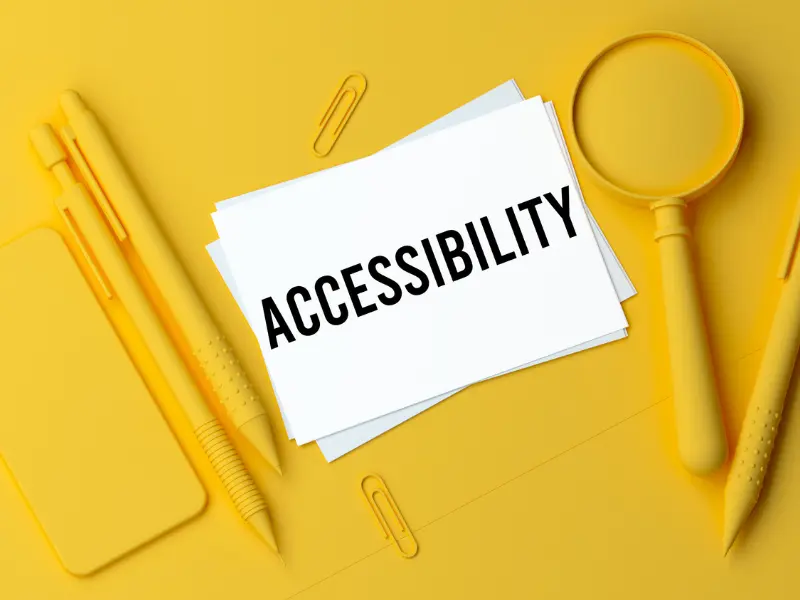What Are The Principles Of Web Accessibility Explained

-
Jim Traister
Ever tried using a website, but it felt impossible to navigate? That’s likely because it wasn’t built with web accessibility in mind. Web accessibility helps people with disabilities use the internet easily.
In this post, you’ll learn how simple changes can make websites work for everyone. Keep reading—it matters!
Key Takeaways
- Web accessibility ensures websites are usable for everyone, including people with disabilities. It improves inclusivity and user experience.
- The four key principles of web accessibility are Perceivable, Operable, Understandable, and Robust (POUR). They guide design to meet diverse needs.
- Features like alt-text for images, captions on videos, keyboard navigation, and simple language help users with disabilities access content easily.
- Accessibility standards, such as WCAG 2.1 or ADA requirements, ensure compliance while future-proofing websites for technological changes.
- Inclusive design benefits all users and avoids legal issues like lawsuits or penalties under laws like Section 508 and the ADA.
Importance of Web Accessibility

Web accessibility opens doors for people with disabilities to use the web effectively. It makes digital spaces more inclusive, benefiting everyone in ways you might not expect.
Ensuring inclusivity for all users
Designing for inclusivity means creating access for people with disabilities and those without. For example, adding keyboard accessibility helps users who can’t use a mouse. Screen readers make text readable to visually impaired users, while alt tags on images provide descriptions they can hear.
Switches or voice controls assist individuals with motor impairments, allowing easier interaction with websites. Inclusive design isn’t limited to vision or mobility; cognitive disabilities also matter.
Simple language, clear icons, and flexible fonts help everyone feel welcome online.
Accessibility is not about perfection — it’s about possibilities.

Meeting the needs of individuals with disabilities
People with disabilities rely on tools like screen readers, text-to-speech software, and on-screen keyboards. These assistive technologies help them access web content. For example, a person who is visually impaired may use audio descriptions to understand images or graphics.
Websites need to offer keyboard accessibility for users who cannot operate a mouse. Shortcuts and large print options make exploring easier for those with motor or visual challenges.
Adding sign language interpretation or braille alternatives can also improve usability for hearing and visually impaired users. Meeting these needs complies with ADA requirements and builds trust and loyalty among all visitors.
The Four Principles of Web Accessibility

Web accessibility stands on four key ideas. These guide how websites work for people of all abilities, no matter their tools or needs.
Perceivable: Making information accessible to all users
Content must be clear for all users, including those with disabilities. Add text alternatives to images so screen readers can describe them. Use subtitles or captions on videos to help people with hearing difficulties.
Choose readable fonts and ensure strong contrast between text and background colors.
Provide audio descriptions for visual content like charts or diagrams. People using assistive technologies, like magnifying tools or voice recognition software, benefit from these adjustments.
Good design enables everyone to use the website easily, leading us next to operable features that enhance usability.
Operable: Ensuring usability for everyone
Websites must work for all users, even those who can’t use a mouse. Keyboard accessibility is key here. For example, someone with limited mobility might rely on shortcut keys or voice commands to interact with web content.
Buttons and links should be easily clickable using only a keyboard.
Avoid flashing elements that could trigger seizures in users with epilepsy. Give enough time for reading text or filling forms—don’t set strict time limits unless absolutely needed.
Clear headings help users find information fast, while simple layouts enhance navigation on tablets, terminals, or desktop browsers like Chrome and Firefox.
Understandable: Providing clear communication and navigation
Clear communication makes a website user-friendly. Labels, buttons, and instructions should use plain language. Avoid technical jargon that confuses users. For example, instead of “Submit Query,” say “Send Message.” Simple labels help everyone understand.
Consistent layouts also matter. Keep menus in the same spot on every page for easy access. Think of airport signs—bold fonts and arrows guide travelers smoothly. The same applies to websites.
Use headings to break content into smaller bits, making it easier to read and skim.
To assist individuals with cognitive disabilities or learning challenges, offer clear feedback messages like “Password too short” or “Email invalid.” Screen reader compatibility ensures visually impaired users can find information easily through assistive technologies.
Next up: ensuring durable design for future accessibility needs!
Robust: Future-proofing for ongoing accessibility
Websites must adapt to changing technologies, devices, and user tools. A future-ready site works well with assistive technology like screen readers or specialized keyboards. This approach keeps content accessible for disabled people as technology evolves.
Think about mobile accessibility too—content should work seamlessly across tablets, phones, and desktops.
Digital accessibility means staying compatible with new browsers, updates, and user agents. Sticking to standards like WCAG 2.1 or WCAG 2.0 AA helps maintain usability over time. Good design ensures everyone can use your site today and tomorrow by meeting these accessibility guidelines.
Web Accessibility Standards

Web accessibility standards set clear rules to create websites that work for everyone, including people with disabilities.
Derived from the Web Content Accessibility Guidelines (WCAG)
The Web Content Accessibility Guidelines (WCAG) sets the gold standard for digital accessibility. These guidelines, created by the World Wide Web Consortium (W3C), help websites meet accessibility goals.
They include success criteria that focus on making content usable for everyone, including people with disabilities.
WCAG principles cover areas like text alternatives for images and keyboard accessibility. For example, screen readers can describe pictures to visually impaired users through alt-text.
WCAG also ensures mobile accessibility and screen reader compatibility across devices like tablets or phones. With updates like WCAG 2.2, websites stay current with technology changes while supporting inclusive design.
Compliance with legal requirements
Web accessibility laws protect the rights of people with disabilities. Titles like Section 508 of the Rehabilitation Act and Title III of the Americans with Disabilities Act (ADA) require accessible digital spaces.
These rules cover websites, web applications, PDFs, and user interfaces.
Failing to meet these standards can result in lawsuits or hefty fines. Businesses must comply by using accessibility guidelines like WCAG. Accessible design should work for assistive technologies such as screen readers and magnifiers.
This also includes making content keyboard accessible for users not relying on a mouse or touchscreens.
Conclusion
Making your website accessible isn’t just smart—it’s necessary. It helps everyone, including people with disabilities, to use and enjoy your site. By following the POUR principles, you provide a better experience for all visitors.
Plus, it keeps your business compliant with laws like ADA and WCAG standards. Start small, aim big, and make the web a place for everyone!
Related Articles
Discover how optimizing images with modern formats and delivery networks can enhance your website's performance and user experience.
Learn the essentials of crafting a visual sitemap to improve site navigation and ensure content is accessible to all users.
Uncover strategies for writing compelling meta descriptions that boost your site's visibility and click-through rates.
Make Your Website Accessible to Everyone ♿
- Use alt-text for images so screen readers can describe them
- Enable full keyboard navigation for users with mobility limitations
- Choose readable fonts and clear contrast for better visibility
- Follow the POUR principles: Perceivable, Operable, Understandable, Robust

About Jim Traister
Learn more


